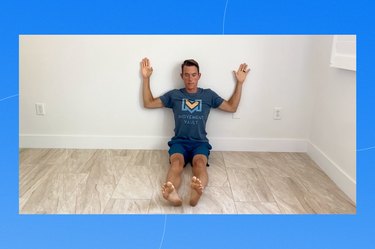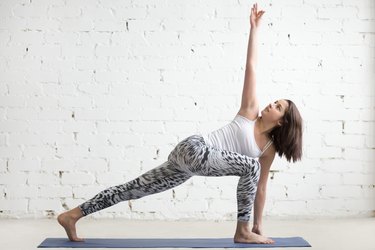We tend to hold tension in certain body parts. Both our hips and pelvic floor are notorious for tight muscles.
Fortunately, there are ways to soothe the strain in these affected areas. Enter: the adductor rock back, a gentle mobility exercise that entails kneeling on one leg while extending the other to the side and softly rocking back and forth.
Video of the Day
The adductor rock back is a terrific twofer as it loosens stiff hips while simultaneously relaxing your pelvic floor. And as a bonus, it also improves flexibility in your inner thighs and supports knee health.
Adductor rock backs are an amazing addition to your regular warm-up routine, says Lee Hanses, PT, DPT, a physical therapist at Bespoke Treatments Seattle. They are particularly important for activities that involve the lower extremities, including running, cycling or lifting weights and/or lateral movements, such as soccer, skiing or roller skating, Hanses says.
- What is the adductor rock back? The adductor rockback, sometimes called a split stance hip rocker, is a dynamic (moving) stretch that targets your lower body.
- What is the adductor rock back good for? This drill relieves tension and stretches tight muscles in your lower body. It can prepare your body for the demands of a hard workout or help you loosen up after a long period of sitting.
- What muscles does the adductor rock back work? Adductor rockbacks primarily stretch your adductors - the muscles on the inside of your thigh - along with your hamstrings and glutes. They can also reduce tension in the deeper muscles of your pelvic floor.
- Who can do the adductor rock back? As long as you can get up and down from the floor, you can perform the adductor rockback. Place a foam pad or pillow underneath your knee to minimize discomfort. This drill won't be a good fit for you if you cannot easily get up and down from the floor.
- How long should you hold the adductor rock back? One set of 10 to 20 reps on each side should do the trick. But if rock backs feel really good, by all means, feel free to add another set or two for a satisfying stretch.
How to Do the Adductor Rock Back
- Kneel on one knee, extending the other leg directly out to the side. Place your hands on the floor out in front of you for support.
- Keeping your spine straight, inhale as you sit your hips back as far as you can before you notice your back begin to round. You should feel the stretch in the inner thigh of your straight leg.
- While exhaling, gently push forward, “rocking back” to the starting position.
Tip
If you have difficulty kneeling, you can modify the movement in a standing position, Hanses says. Here’s how: Start with your feet as wide as possible, then bend one knee and lean into that leg, hinging at the hips to feel a stretch in the inner thigh of the straight leg.
4 Adductor Rock Back Benefits
1. It Builds Better Hip Mobility and Glute Engagement
Many of us have stiff hips due to excessive sitting. This poor hip mobility just gets more pronounced with age because our lifestyles tend to become more sedentary in our later years.
Fortunately, doing adductor rock backs regularly can help offset some of these hip-related issues. "This movement promotes mobilization through the posterior hip capsule, which can become tight and hypomobile as we age," Hanses says.
Plus, happy, healthy hips have a dynamite downstream effect on your derriere. "Maintaining good posterior capsule mobility promotes better glute engagement during exercise," she adds. In other words, good hip mobility enables your glutes — the largest and most powerful muscle in your body — to grow stronger and function better.
Because strong glute muscles are pivotal for performing most types of major movements — like standing, walking, running and scaling stairs — this is a big benefit.
2. It Relieves Tension in Your Pelvic Floor Muscles
Nearly one in 10 people contend with a tight pelvic floor (i.e., the set of muscles that supports your pelvic organs), according to the Cleveland Clinic.
Like any other type of skeletal muscle, your pelvic floor can become too tense. But when your muscles can't relax, they become incapable of the correct coordination necessary to control certain bodily functions, per the Cleveland Clinic. As a result, you may experience problems with peeing and pooping, as well as painful sex.
While adductor rock backs aren't a cure-all for pelvic floor dysfunction, they can help temper some of the tension. "This movement promotes relaxation of the pelvic floor muscles, which can become too tense or tight over time," Hanses says.
Coordinating your breath with the movement can be especially helpful, she adds. Here's how: Exhale as you sit back into the move and inhale as you return to the starting position.
Tip
If you’re experiencing pain or tightness in your pelvic floor, consult with a pelvic floor specialist who can help pinpoint your pelvic problem and provide an individualized treatment plan.
To find a pelvic rehab practitioner near you, check out PelvicRehab.com or the Academy of Pelvic Health Physical Therapy.
3. It Improves Flexibility in Your Inner Thighs
Your inner thighs, aka your adductors, are another area where tightness can creep up.
The rock back "stretches the adductor group from many angles," Hanses says. And having long, loose adductors is advantageous because your inner thigh muscles play an important part in stability and balance.
The exercise's forward and backward rocking motion is beneficial for everyday movements, such as getting in and out of a car or sitting cross-legged on the floor, as well as advanced athletic maneuvers, Hanses says.
4. It Enhances Your Knee Health
When other leg muscles become weak or too tight, this can cause a damaging domino effect down to your knees.
For example, tension in your hips or inner thighs can result in muscular imbalances, creating abnormal forces that are distributed through your knee joint, Hanses says.
"By facilitating adequate mobility and stability [in other areas of the body], we will reduce the likelihood of strain and injury in the knees," she says. Simply put, doing mobility exercises, like rock backs, can reap secondary benefits for your knee health.
This is essential for our knees, which tend to take a beating due to daily wear-and-tear and often become trouble spots for age-related aches and pains like arthritis.
Common Adductor Rock Back Mistakes (and How to Fix Them)
1. You Bend Both Knees
If you want to effectively stretch your adductors, you must keep one of your legs as straight as possible. Don't bend the knee of the leg you're supposed to keep straight as you rock back and forth.
2. Your Foot Position Is Incorrect
It's important to position both of your feet correctly to get the most out of your adductor rock backs and avoid unnecessary joint stress. You don't want the foot of the leg you're keeping straight to rotate up and down as you rock.
Additionally, you should position the foot of the leg you're bending with your toes either pointed behind you or flexed into the floor. Don't turn this foot out to the side or place it outside your hip.
3. You Have Too Much Spinal Movement
Some people rock so far forward that their back arches and their hips sag toward the floor. Other people rock so far back that their low back rounds excessively.
Some movement in your spine is fine, but you don't want a large amount of flexion or extension. Combat this by not rocking too far forward or backward or going to your maximum range of motion.
4. You Don't Center Your Body
Not feeling a stretch? It might be because your torso is too close to your bent knee. Most people will feel a better stretch when their torso is more centered between their legs.
Shift your torso more toward your straight leg, then place your hands in front of the middle of your torso. This should increase the stretch on your straight leg.
5. You Place Your Hands Too Close to Your Body
It's tempting to put your hands directly beneath your shoulders. But if you want to maximize the stretch, you should walk your hands farther out in front of your body. This allows you to gently push your hips back into a deeper stretch.
Adductor Rock Back Modifications
1. Hip Rocker
The hip rocker is the two-leg version of the adductor rock back. Although you won't receive the same adductor stretching benefits, you can still ease pelvic floor tension and loosen up your low back and hips.
Use this variation as a substitution for the adductor rock back or combine the two by performing a set of hip rockers before your adductor rock backs.
- Kneel on both knees with a wide stance, your feet inside your knees. Place your hands on the floor out in front of you for support.
- Keeping your spine straight, inhale as you sit your hips back as far as you can before you notice your back begin to round.
- While exhaling, gently push forward, “rocking back” to the starting position.
2. Banded Adductor Stretch
Some people find it uncomfortable to support their body weight on their hands and knees. If this is you, you can stretch your adductors and hamstrings by lying on your back. All you need is a resistance band or a yoga strap to loop around your foot.
- Loop a long resistance band or yoga strap around your right foot.
- Lie on your back and use the band to gently pull your right leg up and out to the side. Try to keep your leg as straight as possible to increase the stretch.
- Hold the stretch position for 30 to 60 seconds as you take deep, relaxed breaths.
- When time is up, switch sides.
3. Standing Adductor Stretch
If you're unable to get up and down from the floor, you can still loosen up your adductors and hamstrings using this standing stretch. This variation may not be a good fit for people with knee injuries, so talk to your doctor or physical therapist before adding it to your workouts.
- Stand with your feet wider than hip-width apart.
- Bend your left knee and lean into your left leg, hinging at your hips to feel a stretch in the inner thigh of your right leg. Your right leg should be straight.
- You can place your hands on your bent left knee if you need extra support. Or, you can reach your arms out in front of you in a "Y" position.
- Hold this position for 20 to 30 seconds as you take deep, relaxed breaths.
- When time is up, switch sides.
Adductor Rock Back Progressions
1. Adductor Rock Back With Thread the Needle
Once you feel comfortable with adductor rock backs, you can add in thread the needle to stretch your upper back and shoulders. This is a great combo move that targets almost your entire body.
- Kneel on your right knee, extending your left leg directly out to the side. Place your hands on the floor out in front of you for support.
- Keeping your spine straight, rock your hips back as far as you can before you notice your back begin to round. You should feel the stretch in the inner thigh of your straight leg.
- Hold this position.
- Raise your left arm up toward the ceiling and look up at your fingertips.
- Next, "thread” your left arm under your chest until your left shoulder rests on the mat (or as close to it as you can comfortably go) with your palm facing up.
- Make sure your head is turned to the right so that the left side of your face is resting on (or close to) the mat.
- Return to the starting position.
- Repeat for 10 reps per side.
- Then, gently rock forward and repeat on the other side.
2. Kneeling Adductor Hinge
The kneeling adductor hinge adds a strength component to your adductor rock back. Now, you have less support from the floor and must use your core and hip muscles to perform the exercise.
If you want even more of a challenge, try holding a light weight — like a sandbag, kettlebell or medicine ball — in front of your chest.
- Kneel on your right knee, extending your left leg directly out to the side. Clasp your hands at your chest or if you're using weight, hold it tight in front of your chest.
- Keeping your spine straight, inhale and hinge your hips back behind you. You should feel the stretch in the inner thigh of your straight leg. Keep your chest tall and don't allow your upper body to collapse toward the ground.
- While exhaling, gently push your hips forward and drive your knee that's down into the ground.
- Return to the starting position and repeat.
- Switch sides.
How to Add the Adductor Rock Back to Your Routine
1. During a Dynamic Warmup or Cooldown
Many people are tight through their adductors and could benefit from loosening up these crucial muscles before exercise. Add one or two sets of rock backs to your warmup and see if it makes a difference in your run, bike ride or lifting session.
You might also want to perform rock backs at the end of your workout. It can help you cool down, relax your breathing and stretch tight muscles.
2. In the Middle of Your Workout as Active Rest
If you're feeling extra tight, it makes sense to sprinkle some extra sets of adductor rock backs throughout your workout.
This works especially well when you're doing an exercise that uses your adductors and hamstrings. For example, you could perform a set of adductor rock backs to stretch your muscles after a set of Romanian deadlifts or lateral lunges.
3. Sprinkled Throughout Your Day
Sit at a desk all day for work? You're more prone to tightness in your low back, hips and legs. Try performing a set of adductor rock backs every hour (or at whatever frequency works with your schedule) to feel looser and more relaxed.
You can also add adductor rock backs to an existing mobility routine. If you already stretch when you wake up or after you get home from work, try including some adductor rock backs to relax your lower body.
Was this article helpful?
150 Characters Max
0/150
Thank you for sharing!
Thank you for your feedback!


